Birch Trees: Types, Leaves, Bark – Identification (With Images)
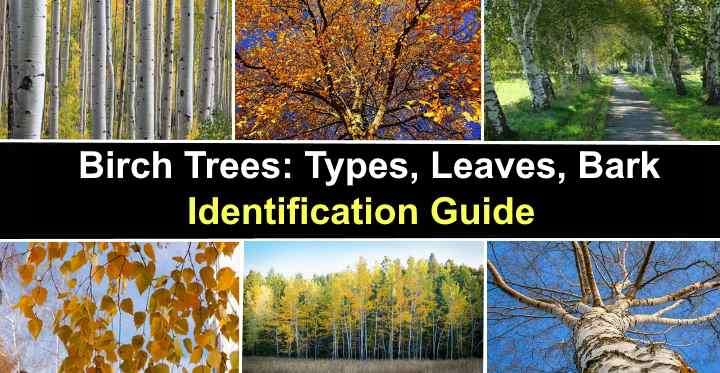
Birch trees (genus Betula) are flowering medium-sized deciduous trees with thin papery bark and egg-shaped pointed leaves. Birch trees have spectacular fall colors that can be golden yellow, vibrant orange, or fiery red. Common birch trees get their names from the bark’s distinctive colors, which can be white, silver, black, gray, or yellow.
Common species of birch include the white birch, silver birch, and paper birch. Typically, you can identify birch trees by their bark, leaves, and flowers. For example, some birches have thin peeling bark that exfoliates in long strips, whereas some species don’t peel. Also, birch leaves can be egg-shaped, triangular, or diamond-shaped.
This article is a guide to identifying common birch trees. Pictures and descriptions of birches will help you choose the best type of ornamental tree for your garden landscape.
Birch Tree Facts

Birch forest
Birch trees belong to the genus Betula in the beech-oak family Fagales. Birch trees typically grow between 40 and 70 ft. (12 – 21 m) tall with canopies 35 to 60 ft. (10 – 18 m) wide. Dwarf birch trees are small trees that don’t grow taller than 30 ft. (9 m), and some only grow 3 ft. (1 m) tall.
There are between 30 and 60 birch (Betula) species, with 18 being native to North America. Birch is a short-lived tree that thrives in cold, northern climates where it grows in moist ground. Birch trees grow best in USDA zones 2 through 7.
Some species of birch have slender, single trunks with irregular-shaped canopies. The birch foliage tends to grow higher up the tree, revealing white-gray, red, or black bark. You’ll also find clumping birch trees with multiple trunks growing together from the ground.
White birch trees are also ornamental trees suitable for residential landscapes.
Birch wood is also prized for its density and strength. Wood from birch trees is used to make skateboards, plywood, and loudspeaker cabinets. Additionally, birch is excellent firewood because it burns well even if damp.
Birch Tree Leaves

Birch tree leaves have pointed tips and serrated edges. On the right picture: autumn foliage
Birch tree leaves are triangular or egg-shaped with a rounded base, pointed tips, and serrated margins. Glossy green birch leaves grow between 2” and 3” (5 – 7.5 cm) long. The simple leaves are arranged alternately on branches. In fall, birch leaves turn spectacular shades of yellow, red, and orange.
There are some subtle differences in leaf shape between species of birch. For example, white birch trees have more pronounced teeth on the leaf margins. River birch leaves tend to have a diamond shape, whereas gray birch leaves are more triangular-shaped.
Birch Bark
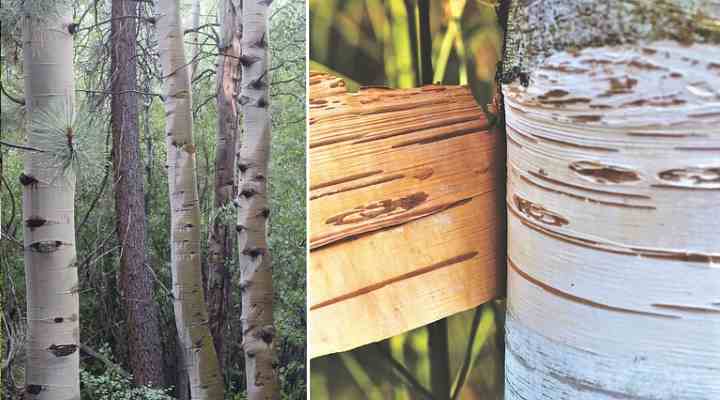
Birch tree bark
Birch tree bark is usually whitish-gray, silver, or sometimes red. The bark on most birch trees has horizontal dark streaks that look like scoring (called lenticels). Birch tree bark is also well-known for its paper-like texture and peeling nature. The peeling bark on birch trees gives them ornamental value in wintertime.
Birch trees with white bark are generally the most popular types of birch trees for gardens.
Birch Flower
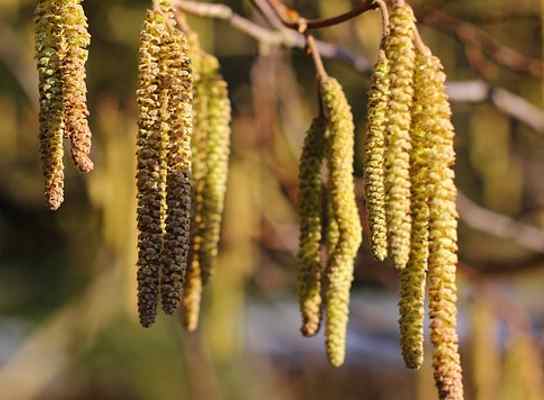
Birch flower are called catkins
Birch tree flowers are small, insignificant clusters of flowering spikes called catkins. Birch trees bloom in spring at the same time leaves appear. Flowers on male birch trees are 1.2” (3 cm) long, and the flowers on female trees are 0.4” to 0.8” (1 – 2 cm) long.
How to Identify Birch Tree
The bark and leaf shape are the best ways to identify species of birch trees. You can recognize birch trees by their peeling bark that can be white, gray, or yellow. You will also notice horizontal diamond-shaped raised marks on the light-colored bark. Look at the leaves—birch leaves are typically triangular with jagged-looking edges.
Birch Trees vs. Aspen Trees — How to Tell Them Apart
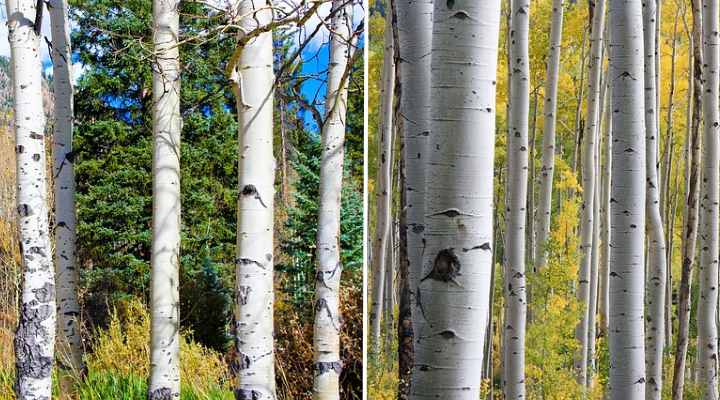
Aspen tree trunks (left) are very similar to birch trunks (right)
It’s easy to mistake birch trees for aspen trees. From a distance, birch trees and aspens look similar with their slender white or gray trunks. However, looking up close, you’ll see that birches have peeling bark, whereas aspen trees have rough, fissured bark.
Another way to tell birch trees apart from aspen trees is by their leaves. Birch leaves tend to be triangular or spear-shaped with noticeable serrated margins. Aspen tree leaves are more heart-shaped with finely toothed edges. Also, birch leaves have a “V” shape and are elongated rather than like the flat leaves of aspens.
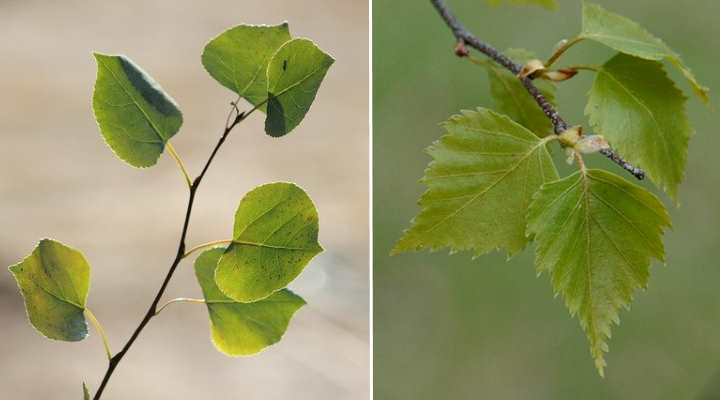
Aspen leaves (left) are usually rounder and shorter than birch leaves (right) and have less serrated edges
Birch Trees in the Fall
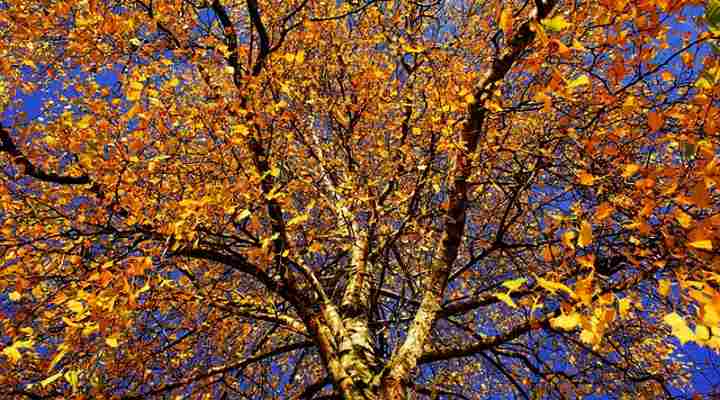
Autumn foliage of birch tree
Birch trees are deciduous trees that have stunning ornamental appeal in the fall. The leaves of birch trees turn from glossy green to magnificent shades of yellow in the fall. Birch tree fall colors can range from golden yellow to warm autumn hues of orange, bronze, and red. Some birch trees have bark that also turns golden like the leaves.
Types of Birch Trees
Let’s look in more detail at the common types of birch trees growing in forests and residential parks and gardens.
White Birch Tree (Betula pubescens)
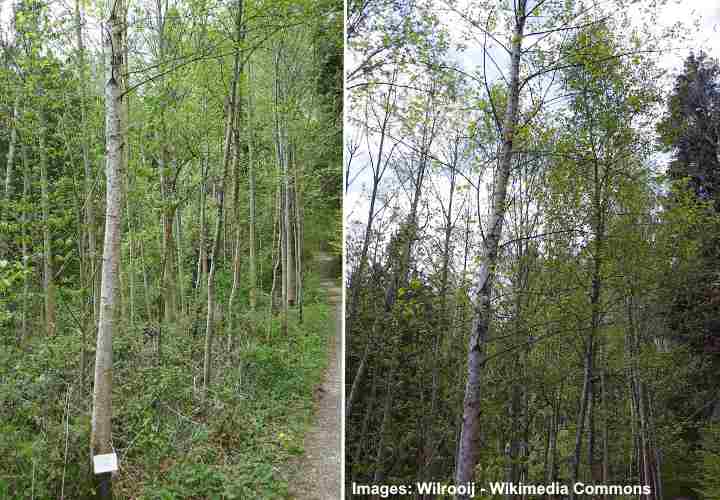
White birch trees (Betula pubescens)
The white birch tree has ovate-shaped fuzzy leaves and white, thin, papery peeling bark. White birch trees grow between 30 and 65 ft. (10 – 20 m) tall. The slender white trunk has upright branches, giving the tree a columnar appearance. White birches have warm yellow fall colors.
White birch (Betula pubescens) is a tree native to Europe. Other names for white birch tree include ‘downy birch,’ ‘hairy birch,’ and ‘moor birch.’ The white birch is sometimes confused with the silver birch (Betula pendula). However, it has smooth downy shoots.
Compared to other birch trees, the leaves of white birch have coarsely serrated margins.
The white birch tree is a cold-hardy broadleaf tree that grows in USDA zones 2 through 9. The tree thrives in full sun and moist, damp ground.
White birch tree leaves: Simple leaves are arranged alternately. The triangular leaves have a rounded base and tapered tip. Also, look for unevenly serrated margins. White birch leaves measure 1.2” to 2.4” (3 – 6 cm) long and up to 2” (5 cm) wide.
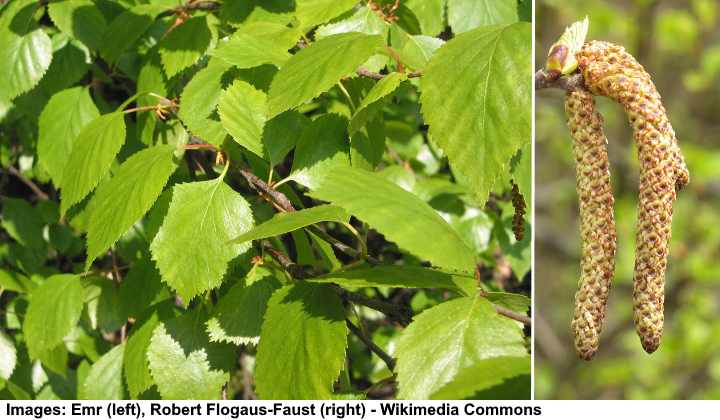
White birch leaves and male catkins
White birch tree bark: Dull white thin bark that exfoliates in papery strips.
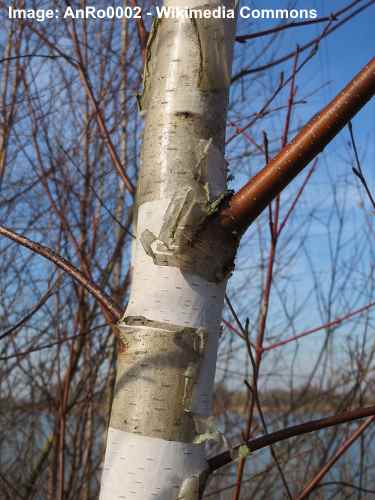
White birch tree bark
Weeping Silver Birch Tree (Betula pendula)
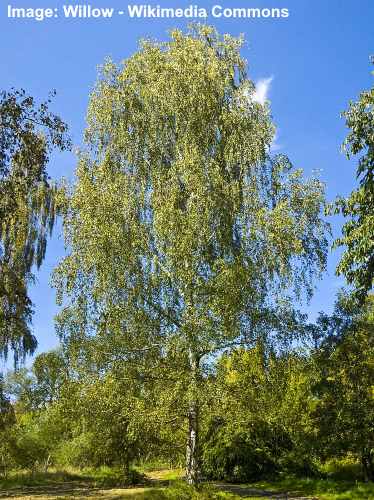
Weeping Silver Birch Tree (Betula pendula)
The silver birch has pendulous branches, giving the tree a weeping appearance. The weeping silver birch has glossy green leaves that turn a warm yellow in the fall. Leaves are ovate-shaped with double-toothed margins. As its name suggests, the bark of Betula pendula is silvery-white and has contrasting horizontal black stripes.
Weeping silver birch trees grow best in large gardens as shade trees. The arching canopy, oval shape, and slender silvery trunk look stunning as a landscape tree.
Silver birch trees are suitable for growing in USDA zones 2 through 7. The deciduous trees prefer full to partial sun and growing in well-draining ground.
The weeping silver birch is also called the ‘lady of the woods,’ ‘weeping birch,’ European white birch,’ ‘warty birch,’ and ‘lady birch.’
Silver birch tree leaves: Shiny green leaves are 2.5” (7 cm) long and have a distinct triangular shape with jaggy-looking edges. Silver birch fall colors are hues of warm yellows.
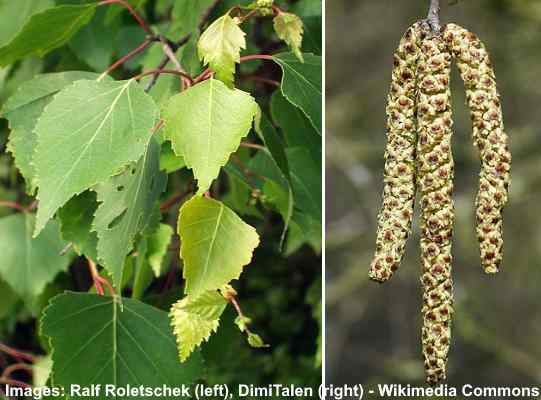
Weeping silver birch leaves and male catkins
Silver birch tree bark: Bark is golden brown on young growth before turning silvery white with black patches.
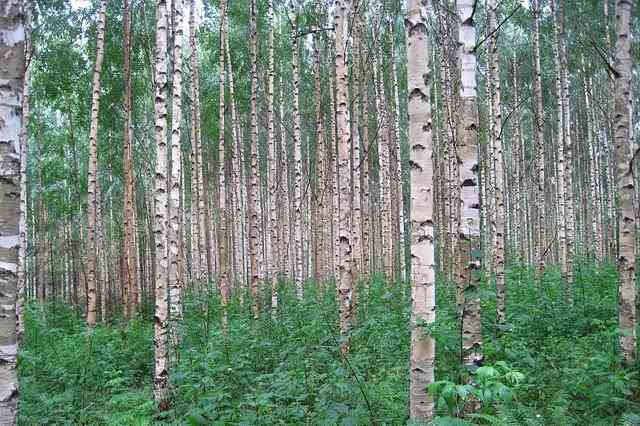
Weeping silver birch bark
Paper Birch Tree (Betula papyrifera)
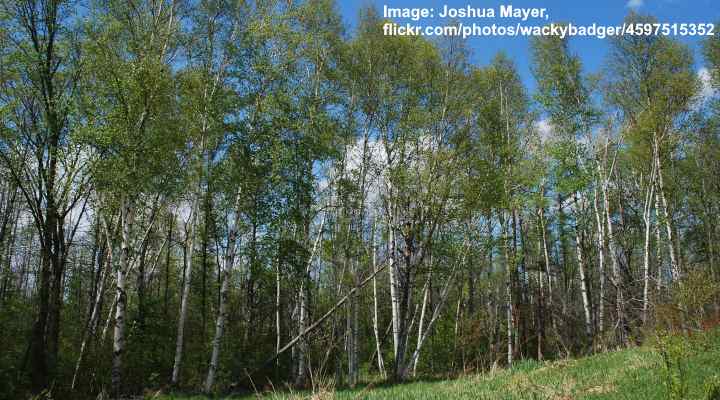
Paper birch trees (Betula papyrifera)
Also called the white birch tree, the paper birch gets its name from its thin, white papery bark. The paper birch tree has ornamental value in garden landscapes due to its golden fall color and thin, exfoliating, smooth pure white bark. Leaves are egg-shaped with irregularly toothed margins.
You can grow paper birch trees as a single stem tree or multi-stemmed tree. Typically, paper birch trees grow between 50 and 70 ft. (15 – 21 m) tall and have a rounded crown. Multi-stemmed paper birch trees don’t grow as tall.
Paper birch trees grow best in USDA zones 2 through 7. In cold climates, ornamental paper birch trees can grow for up to 100 years. In warmer regions, they don’t live as long.
The paper birch tree was used to make canoes. That’s why the Betula papyrifera tree is also called the canoe birch tree. Its brilliant white bark is the reason it’s called the white birch.
Paper birch tree leaves: Ovate-shaped leaves with irregular serration on the margins. The leaf blades measure 4” (10 cm) long and turn from dark green to bright yellow in the fall.

Paper birch leaves
Paper birch tree bark: Shiny white bark that peels in strips revealing orangey-brown bark underneath.
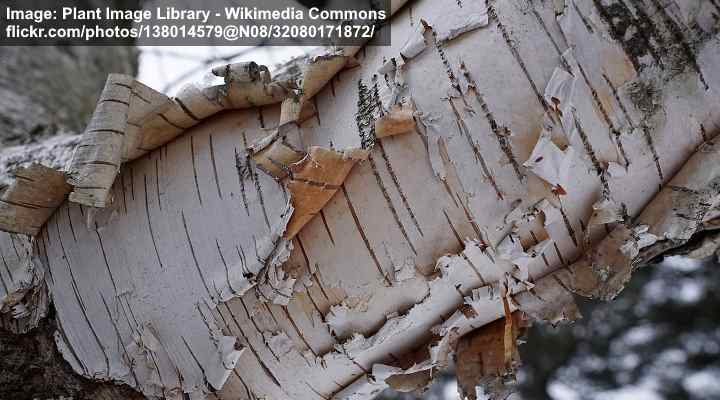
Paper birch bark
Yellow Birch Tree (Betula alleghaniensis)
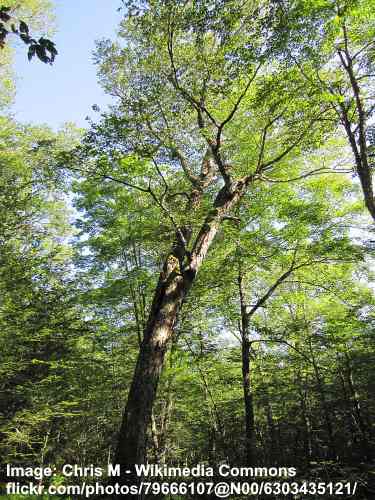
Yellow birch tree (Betula alleghaniensis)
The yellow birch tree is a medium-sized tree with elongated oval, glossy green leaves, finely serrated margins, and beautiful bright yellow colors in the fall. This slender deciduous tree has foliage growing in a conical shape. The tree’s bark starts as shiny bronze before turning shaggy and papery and a gray-brown color.
Yellow birch trees grow between 50 and 80 ft. (15 – 24 m) tall. Yellow birches have year-long seasonal interest thanks to the beautiful bark, large pointed leaves, and bright fall colors.
Other names for yellow birch tree include ‘swamp birch,’ ‘gray birch,’ ‘hard birch,’ and ‘silver birch.’
Yellow birch tree leaves: Lanceolate shaped with irregularly toothed margins. Dark green birch leaves turn bright yellow with hints of lime green in fall. The long birch leaves measure between 3” and 5” (7 – 12 cm) long.

Yellow birch leaves
Yellow birch tree bark: The bark is a polished brown color when young and turns a silvery-gray color as it matures. The bark has a yellow-bronze tinge that peels in narrow strips.
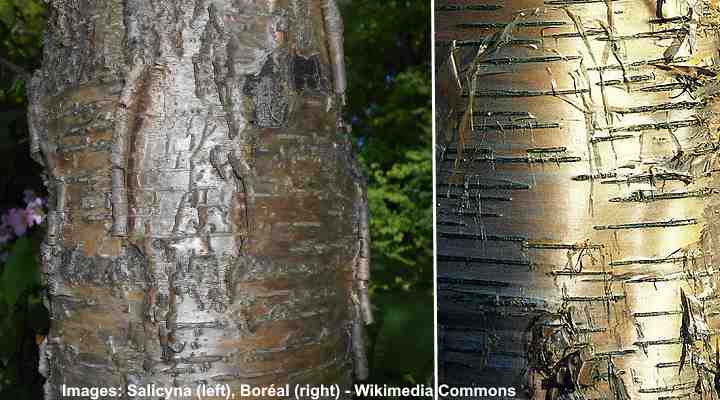
Yellow birch bark
River Birch Tree (Betula nigra)
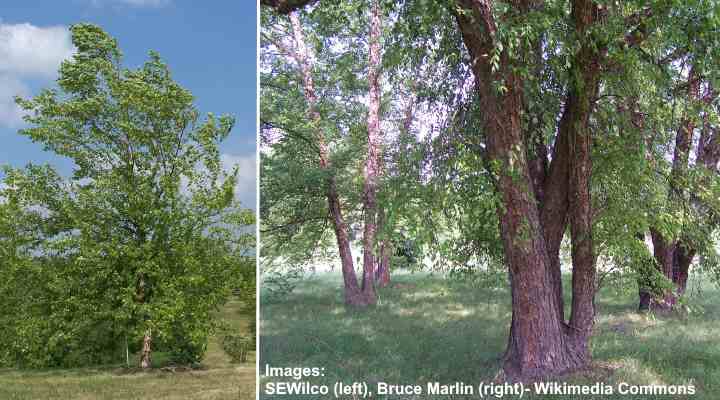
River birch trees (Betula nigra)
The river birch tree is a type of clumping birch tree with reddish-brown exfoliating bark, glossy green diamond-shaped leaves, and a pyramidal crown. This fast-growing river birch tree has smooth fuzzy twigs and unique buds among Betula trees due to the hooked tips. River birch fall color is golden yellow.
Betula nigra grows between 80 and 100 ft. (25 – 30 m) and typically has multiple slender trunks. The clumping river birch grows best as decorative trees in garden landscapes where there’s wet soil.
The river birch is the best choice of birch trees for hotter areas. River birches are the most heat-tolerant of all the Betula species. You’ll find river birch thriving in northern states, as well as Florida and Texas. This birch species grows in USDA zones 4 through 9.
Other names for the river birch include ‘black birch,’ ‘water birch,’ or ‘clump river birch.’
River birch tree leaves: Diamond-shaped leaves with double-serrated margins. The birch leaves have a glossy green upper side and yellowish-green underside. In fall, all the foliage turns bright yellow.
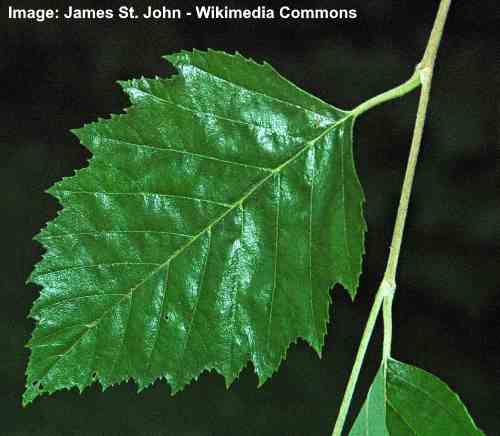
River birch leaf
River birch tree bark: Flaky bark that peels and curls from the tree trunk. The bark starts pink, smooth, and shiny. As the birch tree matures, the bark becomes reddish-brown and peels, revealing orangey flakes of bark.
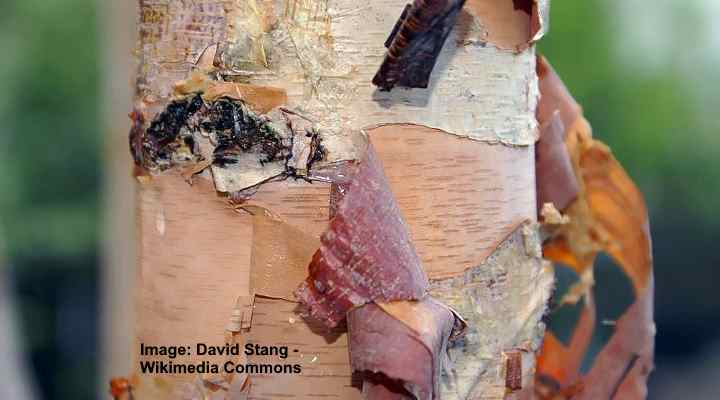
River birch bark
Gray Birch Tree (Betula populifolia)

Gray birch tree (Betula populifolia)
The gray birch tree is a fast-growing, slender deciduous tree, often with multiple trunks. Gray birch leaves are triangular shaped with an elongated tip. The ovate leaves have a glossy green upper side and a pale underside. Gray birch bark is a light gray, almost white color with black patches on the bark.
Gray birch trees are medium-sized trees, growing between 20 and 30 ft. (6 – 10 m).
The scientific name for gray birch trees—Betula populifolia—comes from the leaves that look like leaves on poplar trees.
Gray birch trees can look like paper birch trees. However, to tell the trees apart, look at the bark and leaves. Gray birch bark doesn’t peel, and the leaves have longer pointed tips than paper birch trees.
Gray birch tree leaves: Triangular leaves that taper to a long tip. Look for double-toothed margins and shiny upper leaves to identify gray birch trees. Fall color is an undistinguished yellow.
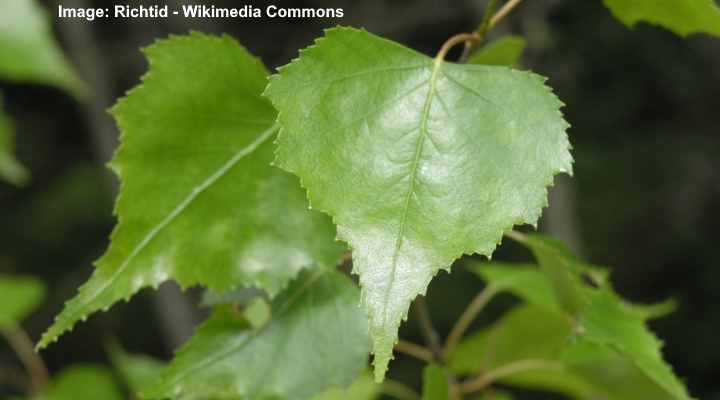
Gray birch leaves
Gray birch tree bark: Chalky whitish-gray bark that doesn’t peel.

Gray birch bark
Sweet Birch Tree (Betula lenta)
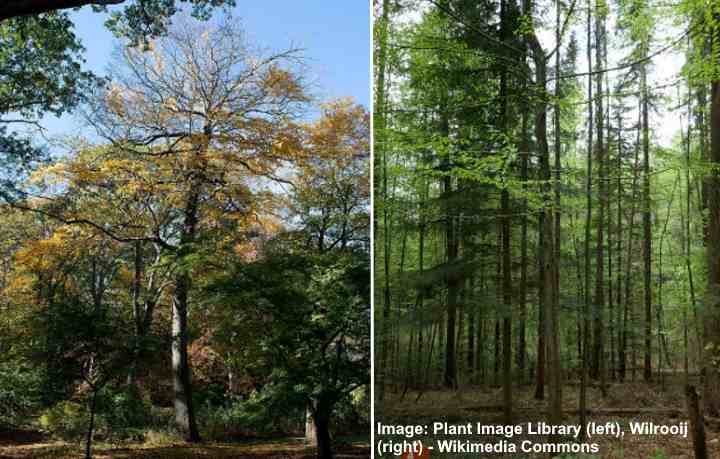
Sweet birch tree (Betula lenta)
The sweet birch tree is a deciduous tree with large, ovate-shaped leaves that have finely serrated margins. Leaves on sweet birch trees are some of the biggest in the Betula genus, measuring up to 6” (15 cm) long. Pendulous flowers emerge in spring before the leaves appear.
The sweet birch tree gets its name from the scent of wintergreen in the twigs, bark, and leaves. The other common names of Betula lenta refer to other features of the tree. For example, ‘black birch’ due to its dark bark color. ‘Cherry birch’ and ‘mahogany birch’ because of the way the bark looks on mature birch trees. And ‘spice birch’ due to the aromatic wintergreen scent it emits.
Sweet birch trees grow up to 100 ft. (30 m) tall. However, these birch trees typically grow in residential landscapes between 50 and 80 ft. (15 – 24 m) tall.
Sweet birch tree leaves: The glossy leaves start as a light green color before becoming a darker shade and then turning to rich golden yellow in the fall. Leaves measure between 2” and 6” (5 – 15 cm). These birch leaves give off a sweet fragrance when crushed.
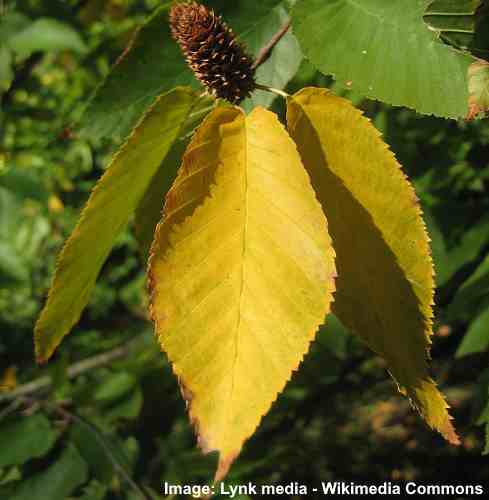
Sweet birch leaves
Sweet birch tree bark: Younger sweet birch trees have smooth grayish bark with slender horizontal lenticels. Unlike other birch trees, older trees develop hard, deeply-fissured bark with irregular scaly plates.
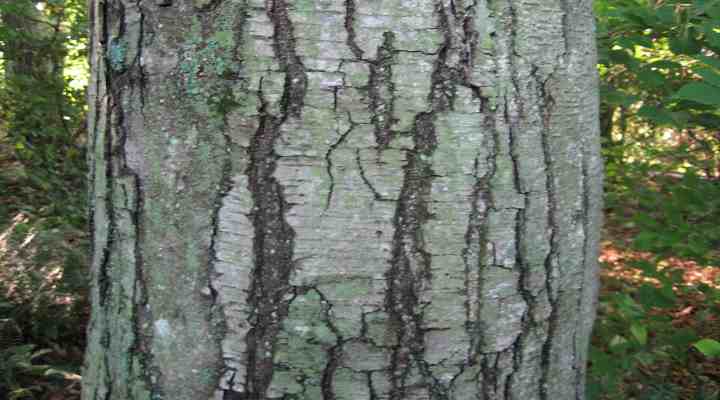
Sweet birch bark
Dwarf Birch Tree (Betula nana)
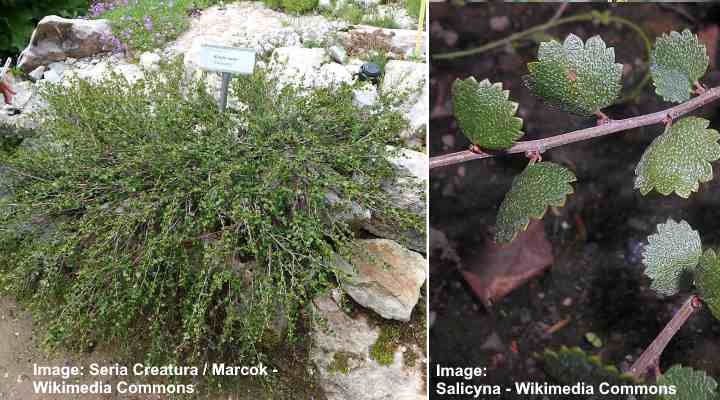
Dwarf birch tree (Betula nana) and a close up picture of the leaves
The dwarf birch tree is more of a large shrub than a tree. This shrubby plant grows around 3 ft. (1 m) tall and has rounded leaves with bluntly-toothed edges. Leaves are light green and turn red in the fall. Dwarf birch trees are well-suited to arctic conditions and thrive in USDA zones 1 through 8.
Apart from dwarf birch tree, other names for Betula nana include ‘bog birch’ and ‘arctic birch.’
The American dwarf birch (Betula glandulosa) is similar to Betula nana. The only difference is longer petioles joining the leaf blades to twigs.
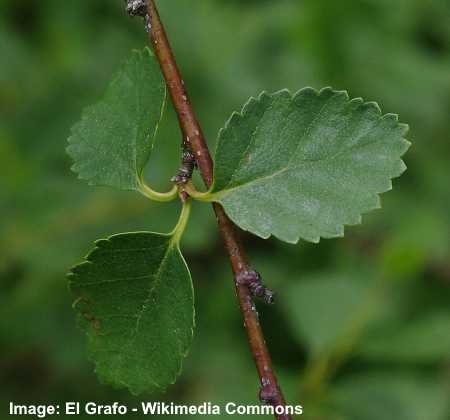
Betula glandulosa leaves have longer petioles
Himalayan Birch Tree (Betula utilis)
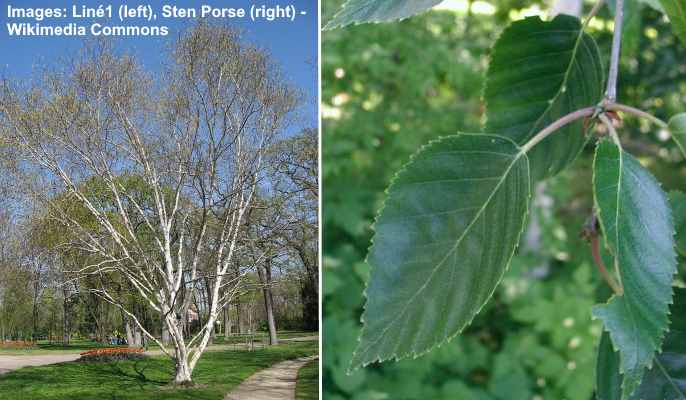
Himalayan birch tree (Betula utilis) and leaves
The Himalayan birch tree has thin, papery bark, egg-shaped, slightly fuzzy leaves, and short conical flowers. Like most birches, the Himalayan birch has peeling bark that can be white, reddish-brown, or reddish-white. The bark peels in thin sheets, revealing pinkish bark underneath. The glossy green birch leaves measure between 2” and 4” (5 – 10 cm).
The Himalayan birch tree grows as a large shrub or tree up to 66 ft. (20 m) tall. The single trunk branches out low to the ground to create a vase-shaped crown of green foliage contrasting with white bark.
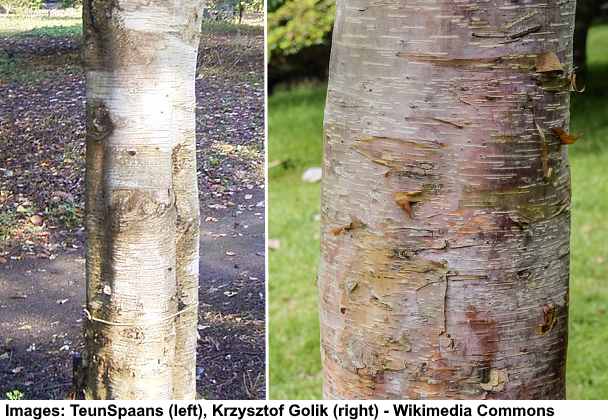
Himalayan birch tree bark
Japanese White Birch (Betula platyphylla)

Japanese white birch (Betula platyphylla) trees and bark
Also called the ‘Asian white birch,’ the Betula platyphylla has grayish-white bark, spreading branches, and yellowish-green triangular leaves with tapered tips. The 3-inch (7.5-cm) leaves have toothed margins and cover branches to create a pyramidal crown.
The Japanese white birch thrives in zones 4 through 7. In colder climates, the decorative birch tree grows between 30 and 40 ft. (10 – 12 m) and is 15 to 25 ft. (4.5 – 7.6 m) wide.
Related articles:
